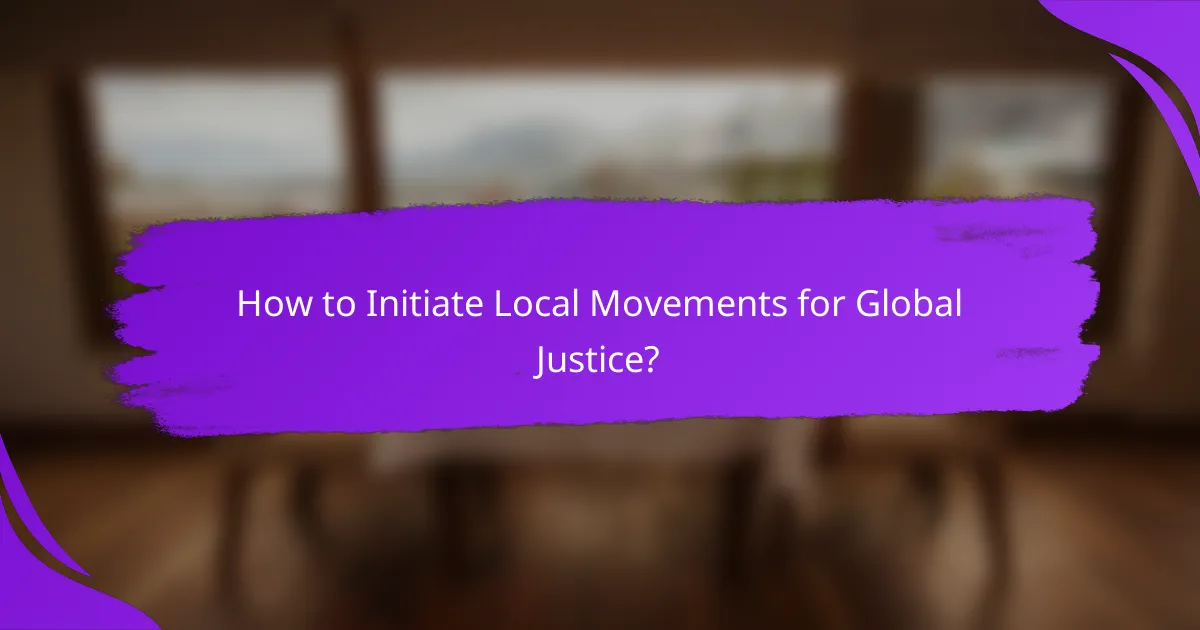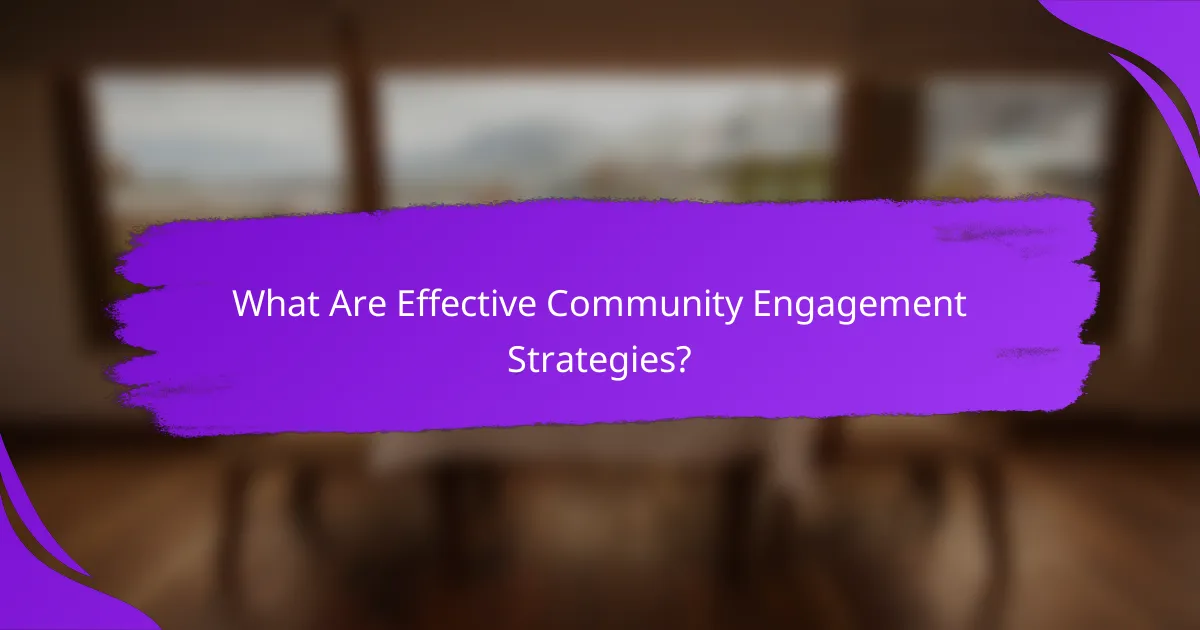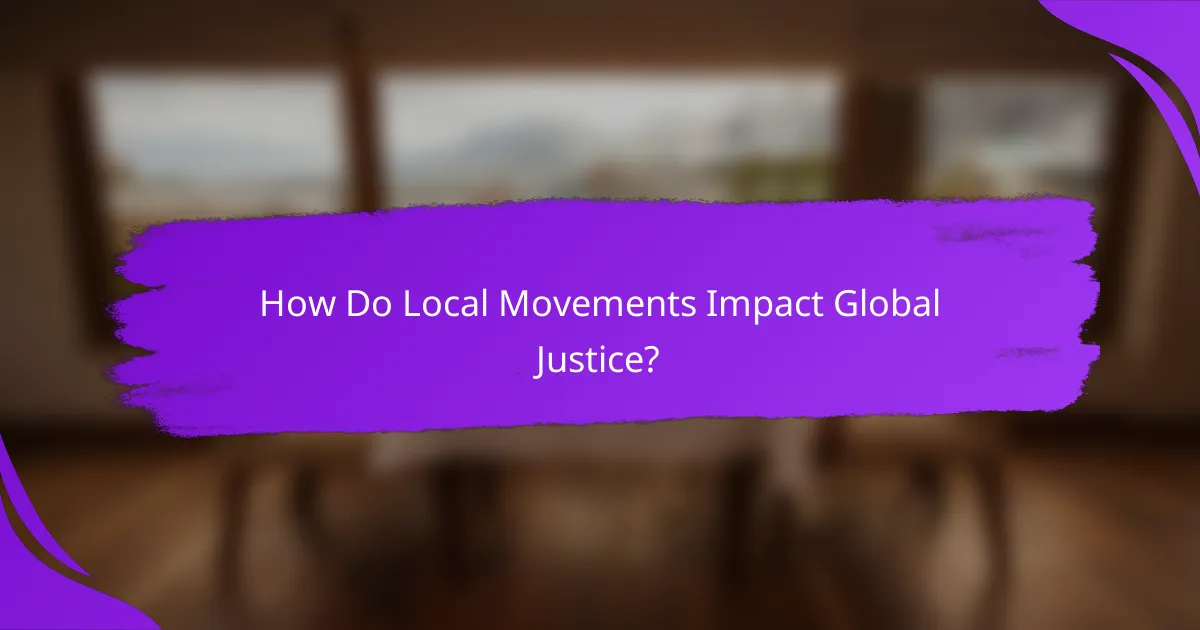Local movements play a crucial role in advancing global justice by addressing specific community issues while linking them to broader challenges. By engaging stakeholders and fostering collaboration, these initiatives can raise awareness and inspire collective action, ultimately creating a ripple effect that influences policies and promotes solidarity across borders.

How to Initiate Local Movements for Global Justice?
To initiate local movements for global justice, start by understanding the specific issues affecting your community and how they connect to broader global challenges. Engaging local stakeholders and leveraging available resources can amplify your impact and foster a sense of collective responsibility.
Identify community needs
Identifying community needs is crucial for launching an effective local movement. Conduct surveys, hold focus groups, or engage in one-on-one conversations to gather insights about the most pressing issues faced by residents. This information will help tailor your movement’s goals to address real concerns.
Consider using tools like community mapping to visualize needs and resources. This can highlight areas requiring immediate attention and facilitate targeted action plans that resonate with community members.
Engage local leaders
Engaging local leaders is essential for gaining support and legitimacy for your movement. Identify influential figures within the community, such as elected officials, business owners, or respected activists, and invite them to participate in discussions about your movement’s objectives.
Building relationships with these leaders can lead to valuable endorsements and resources. They can also help mobilize their networks, increasing your movement’s visibility and reach.
Leverage social media
Social media is a powerful tool for raising awareness and mobilizing support for local movements. Create dedicated pages or groups on platforms like Facebook, Twitter, or Instagram to share updates, resources, and calls to action. Use engaging content, such as videos and infographics, to capture attention.
Consider establishing a consistent posting schedule and utilizing relevant hashtags to increase your visibility. Engaging with followers through comments and messages can also foster a sense of community and encourage participation.
Organize community events
Organizing community events can strengthen your movement by fostering connections among participants. Host workshops, town hall meetings, or informational sessions to educate the community about global justice issues and your movement’s goals.
Ensure events are inclusive and accessible, considering factors like location, timing, and language. Collaborating with local organizations can also enhance event credibility and attract a diverse audience.
Build partnerships with NGOs
Building partnerships with non-governmental organizations (NGOs) can provide valuable resources and expertise for your local movement. Research NGOs that align with your goals and reach out to explore potential collaborations.
These partnerships can offer access to funding, training, and advocacy tools that can enhance your movement’s effectiveness. Additionally, NGOs often have established networks that can help amplify your message and reach a wider audience.

What Are Effective Community Engagement Strategies?
Effective community engagement strategies foster collaboration and participation among community members, enhancing their connection to local movements. These strategies can lead to greater awareness, support, and action towards shared goals.
Host workshops and forums
Hosting workshops and forums allows community members to gather, share ideas, and discuss pressing issues. These events can be structured to encourage open dialogue, where participants feel safe to express their thoughts and concerns.
Consider organizing workshops on specific topics relevant to your community, such as environmental sustainability or social justice. Aim for a mix of expert-led sessions and peer discussions to cater to diverse interests and expertise levels.
Utilize storytelling techniques
Storytelling is a powerful tool for community engagement, as it helps convey complex issues in relatable ways. By sharing personal experiences, community members can connect emotionally, fostering empathy and understanding among diverse groups.
Encourage individuals to share their stories through various mediums, such as video, written narratives, or live presentations. This approach not only humanizes issues but also empowers participants to take ownership of their narratives.
Encourage volunteer participation
Encouraging volunteer participation is essential for building a strong community. By providing opportunities for individuals to contribute their time and skills, you can enhance community cohesion and drive collective action.
Offer a range of volunteer activities, from organizing events to participating in local clean-ups. Clearly communicate the impact of their contributions, which can motivate more people to get involved and sustain their commitment over time.
Implement feedback mechanisms
Implementing feedback mechanisms ensures that community members feel heard and valued. Regularly soliciting input helps organizations adapt their strategies to better meet the needs and preferences of the community.
Consider using surveys, suggestion boxes, or community meetings to gather feedback. Make it a priority to act on this feedback and communicate any changes made as a result, reinforcing the importance of community voices in decision-making processes.

How Do Local Movements Impact Global Justice?
Local movements significantly influence global justice by raising awareness, shaping policies, and fostering solidarity across borders. These grassroots initiatives connect local issues to broader global challenges, creating a ripple effect that can lead to substantial change.
Raise awareness of global issues
Local movements play a crucial role in highlighting global issues such as climate change, human rights abuses, and economic inequality. By organizing events, campaigns, and educational programs, they inform their communities about how these issues affect their lives and the world at large.
For instance, a community-led initiative focused on environmental sustainability can draw attention to the impacts of pollution and deforestation, linking local actions to global environmental movements. This awareness can mobilize local populations to advocate for broader systemic changes.
Influence policy changes
Local movements can effectively influence policy changes at both local and national levels. By advocating for specific reforms, they can pressure governments to adopt policies that align with global justice principles, such as fair labor practices or equitable resource distribution.
For example, a local campaign for affordable housing can lead to policy shifts that address housing inequality, reflecting a commitment to social justice. Engaging with policymakers through petitions, public forums, and lobbying can amplify their demands and create a pathway for legislative change.
Foster international solidarity
Local movements often build networks that connect activists across different regions, fostering international solidarity. By sharing strategies, resources, and experiences, these movements can strengthen their collective impact on global justice issues.
Participating in international conferences or online platforms can help local groups align their goals with global movements, creating a unified front against injustices. This solidarity can lead to joint campaigns that amplify their voices and increase pressure on global institutions to act.

What Criteria Should Be Considered for Successful Movements?
Successful movements require clear criteria that guide their formation and execution. Key factors include well-defined goals, strong leadership, and effective communication strategies that resonate with the community and stakeholders.
Clear goals and objectives
Establishing clear goals and objectives is crucial for any movement’s success. These goals should be specific, measurable, achievable, relevant, and time-bound (SMART), allowing participants to understand the movement’s purpose and direction.
For example, a local environmental movement might aim to reduce plastic waste in the community by 30% within two years. This clarity helps rally support and keeps efforts focused.
Strong leadership and organization
Strong leadership and organization are essential for mobilizing resources and maintaining momentum. Effective leaders inspire trust and motivate participants, while a well-structured organization ensures that tasks are delegated and progress is tracked.
Movements often benefit from a diverse leadership team that represents various community voices, enhancing inclusivity and broadening appeal. Regular meetings and clear roles help maintain organization and accountability.
Effective communication strategies
Effective communication strategies are vital for engaging the community and spreading awareness. Utilizing various channels, such as social media, local events, and community meetings, can help convey messages and attract supporters.
It’s important to tailor messages to different audiences, ensuring they resonate with their values and concerns. For instance, using storytelling can make the movement’s goals more relatable and compelling, fostering a stronger connection with the community.

How to Measure the Success of Local Movements?
Measuring the success of local movements involves evaluating their impact, engagement, and sustainability. Key indicators include community participation, policy changes, and the movement’s ability to maintain momentum over time.
Community Engagement Metrics
Community engagement metrics are essential for assessing how well a local movement connects with its audience. This can include the number of active participants, social media interactions, and attendance at events. Tracking these metrics helps gauge the movement’s reach and resonance within the community.
For example, a movement might aim for a specific percentage increase in social media followers or event attendance over a set period. Regular surveys can also provide insights into community sentiment and involvement levels.
Policy Impact Assessment
Evaluating policy impact is crucial for understanding a movement’s effectiveness in driving change. This involves analyzing any legislation or local regulations influenced by the movement’s efforts. Success can be indicated by the number of policies enacted or modified as a direct result of advocacy.
Consider using a timeline to track policy changes alongside movement milestones. This can help visualize the correlation between grassroots efforts and legislative outcomes, providing a clearer picture of success.
Sustainability and Longevity
Sustainability and longevity are vital for the ongoing success of local movements. A movement that can adapt and continue to engage its community over time is more likely to achieve lasting change. Key factors include leadership continuity, funding sources, and the ability to respond to community needs.
Establishing a clear plan for future activities and funding can enhance sustainability. Movements should consider diversifying their funding sources, such as grants, donations, or partnerships, to ensure they can maintain operations and outreach efforts effectively.


